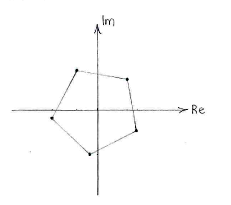Lösung 3.3:2c
Aus Online Mathematik Brückenkurs 2
| (Der Versionsvergleich bezieht 11 dazwischen liegende Versionen mit ein.) | |||
| Zeile 1: | Zeile 1: | ||
| - | + | Wir bringen <math>z</math> und <math>-1-i</math> in Polarform. | |
| - | <math>z | + | |
| - | + | ||
| - | <math> | + | |
| - | in | + | |
| + | {{Abgesetzte Formel||<math>\begin{align} | ||
| + | z &= r(\cos\alpha + i\sin\alpha)\,\\[5pt] | ||
| + | -1-i &= \sqrt{2}\Bigl(\cos\frac{5\pi}{4} + i\sin\frac{5\pi}{4}\Bigr) | ||
| + | \end{align}</math>}} | ||
| - | + | Mit den Moivreschen Gesetz erhalten wir die Gleichung | |
| - | + | ||
| - | + | ||
| - | + | ||
| + | {{Abgesetzte Formel||<math>r^5(\cos 5\alpha + i\sin 5\alpha) = \sqrt{2}\Bigl(\cos \frac{5\pi}{4} + i\sin\frac{5\pi}{4}\Bigr)\,\textrm{.}</math>}} | ||
| - | + | Wir vergleichen den Betrag und das Argument der beiden Seiten und erhalten | |
| + | {{Abgesetzte Formel||<math>\left\{\begin{align} | ||
| + | r^5 &= \sqrt{2}\,,\\[5pt] | ||
| + | 5\alpha &= \frac{5\pi}{4} + 2n\pi\,,\quad\text{(n ist eine beliebige ganze Zahl).} | ||
| + | \end{align}\right.</math>}} | ||
| - | <math>r^{5}\left( \cos 5\alpha +i\sin 5\alpha \right)=\sqrt{2}\left( \cos \frac{5\pi }{4}+i\sin \frac{5\pi }{4} \right)</math> | ||
| + | Die Argumente <math>5\alpha</math> und <math>5\pi/4</math> können sich mit einem Vielfachen von <math>2\pi</math> unterscheiden und trotzdem derselben komplexen Zahl entsprechen. | ||
| - | + | Wir erhalten also | |
| + | {{Abgesetzte Formel||<math>\left\{\begin{align} | ||
| + | r &= \sqrt[5]{\sqrt{2}} = \bigl(2^{1/2}\bigr)^{1/5} = 2^{1/10}\,,\\[5pt] | ||
| + | \alpha &= \frac{1}{5}\Bigl(\frac{5\pi}{4}+2n\pi\Bigr) = \frac{\pi}{4} + \frac{2n\pi}{5}\,,\quad\text{(n ist eine beliebige ganze Zahl).} | ||
| + | \end{align}\right.</math>}} | ||
| - | <math> | + | Wir sehen, dass das Argument <math>\alpha</math> nur 5 verschiedene Werte annimmt |
| - | + | ||
| - | + | ||
| - | + | ||
| + | {{Abgesetzte Formel||<math>\frac{\pi}{4}</math>, <math>\quad\frac{\pi}{4}+\frac{2\pi}{5}</math>, <math>\quad\frac{\pi}{4}+\frac{4\pi}{5}</math>, <math>\quad\frac{\pi}{4}+\frac{6\pi}{5}\quad</math> und <math>\quad\frac{\pi}{4}+\frac{8\pi}{5}</math>,}} | ||
| - | + | da sich die Winkel dann wiederholen. | |
| - | + | ||
| - | + | ||
| - | + | ||
| - | + | ||
| - | + | ||
| - | + | ||
| - | + | Die Wurzeln sind also | |
| + | {{Abgesetzte Formel||<math>z = 2^{1/10}\,\Bigl(\cos\Bigl(\frac{\pi}{4}+\frac{2n\pi}{5}\Bigr) + i\sin\Bigl(\frac{\pi}{4}+\frac{2n\pi}{5}\Bigr)\Bigr)\,,</math>}} | ||
| - | <math> | + | für <math>n=0</math>, <math>1</math>, <math>2</math>, <math>3</math> und |
| - | + | <math>4</math>. | |
| - | + | ||
| - | + | ||
| + | [[Image:3_3_2_c.gif|center]] | ||
| - | + | Alernativer Lösungsweg: [[3.3:2c_alternativ_exp|Exponentialdarstellung]] | |
| - | + | ||
| - | + | ||
| - | + | ||
| - | + | ||
| - | + | ||
| - | + | ||
| - | + | ||
| - | + | ||
| - | + | ||
| - | + | ||
| - | + | ||
| - | + | ||
| - | + | ||
| - | + | ||
| - | + | ||
| - | + | ||
| - | + | ||
| - | + | ||
| - | + | ||
| - | + | ||
| - | + | ||
| - | + | ||
| - | + | ||
| - | + | ||
| - | + | ||
| - | + | ||
| - | [[ | + | |
Aktuelle Version
Wir bringen \displaystyle z und \displaystyle -1-i in Polarform.
| \displaystyle \begin{align}
z &= r(\cos\alpha + i\sin\alpha)\,\\[5pt] -1-i &= \sqrt{2}\Bigl(\cos\frac{5\pi}{4} + i\sin\frac{5\pi}{4}\Bigr) \end{align} |
Mit den Moivreschen Gesetz erhalten wir die Gleichung
| \displaystyle r^5(\cos 5\alpha + i\sin 5\alpha) = \sqrt{2}\Bigl(\cos \frac{5\pi}{4} + i\sin\frac{5\pi}{4}\Bigr)\,\textrm{.} |
Wir vergleichen den Betrag und das Argument der beiden Seiten und erhalten
| \displaystyle \left\{\begin{align}
r^5 &= \sqrt{2}\,,\\[5pt] 5\alpha &= \frac{5\pi}{4} + 2n\pi\,,\quad\text{(n ist eine beliebige ganze Zahl).} \end{align}\right. |
Die Argumente \displaystyle 5\alpha und \displaystyle 5\pi/4 können sich mit einem Vielfachen von \displaystyle 2\pi unterscheiden und trotzdem derselben komplexen Zahl entsprechen.
Wir erhalten also
| \displaystyle \left\{\begin{align}
r &= \sqrt[5]{\sqrt{2}} = \bigl(2^{1/2}\bigr)^{1/5} = 2^{1/10}\,,\\[5pt] \alpha &= \frac{1}{5}\Bigl(\frac{5\pi}{4}+2n\pi\Bigr) = \frac{\pi}{4} + \frac{2n\pi}{5}\,,\quad\text{(n ist eine beliebige ganze Zahl).} \end{align}\right. |
Wir sehen, dass das Argument \displaystyle \alpha nur 5 verschiedene Werte annimmt
| \displaystyle \frac{\pi}{4}, \displaystyle \quad\frac{\pi}{4}+\frac{2\pi}{5}, \displaystyle \quad\frac{\pi}{4}+\frac{4\pi}{5}, \displaystyle \quad\frac{\pi}{4}+\frac{6\pi}{5}\quad und \displaystyle \quad\frac{\pi}{4}+\frac{8\pi}{5}, |
da sich die Winkel dann wiederholen.
Die Wurzeln sind also
| \displaystyle z = 2^{1/10}\,\Bigl(\cos\Bigl(\frac{\pi}{4}+\frac{2n\pi}{5}\Bigr) + i\sin\Bigl(\frac{\pi}{4}+\frac{2n\pi}{5}\Bigr)\Bigr)\,, |
für \displaystyle n=0, \displaystyle 1, \displaystyle 2, \displaystyle 3 und \displaystyle 4.
Alernativer Lösungsweg: Exponentialdarstellung

